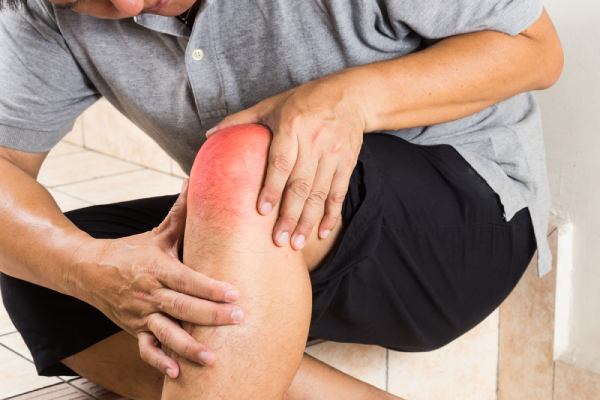
When most people think of gout, they automatically associate it with pain in the big toe’s joint. While the big toe is the most commonly affected joint, it may surprise you that gout can affect other joints in the body, including knees and elbows.
In fact, people often have gout flares in their knees without knowing the pain they feel is caused by gout. Many people will brush off knee pain as a possible injury or the early signs of ageing and wear and tear on the joint.
Knee pain can be a common symptom of a sporting or overuse injury, but also it can be from several types of arthritis. Sometimes pain can manifest in the knee for seemingly no reason, but if you find your knee pain and stiffness are accompanied by a burning pain or sensation, and the joint is warm to the touch, it could be down to a gout flare in your knee.
Because gout is so commonly associated with the big toe joint, many people will dismiss the idea of having gout in their knees. However, gout can flare in areas of the body that already have arthritis – such as the knee joint.
Can gout affect both knees?
In general, gout flares tend to work their way up the body. If you experience pain in your big toe joint and suspect it may be gout, it can help to get a proper diagnosis from a professional rheumatologist.
If your gout condition is left undiagnosed and untreated, it can work its way up from your big toe and start to affect the joints above from the ankle to the knee, and then can reach the lower spine, and so on.
While gout can affect both knees, it can be felt more strongly in one knee, especially if that joint is already affected by arthritis.
What Causes Gout in the Knee?
Gout is an inflammatory condition that occurs when there is too much uric acid in the body. Uric acid is a biological waste product and is a perfectly natural substance created by the body. Excess production of uric acid is medically known as hyperuricemia.
As part of everyday waste removal processes in the body, uric acid is excreted through the kidneys. However, some people are prone to generating higher uric acid levels than usual. This can lead to uric acid forming oxalate crystals in various joints around the body, most commonly in the joint of the big toe, but in other joints too.
When these crystals build up in the knee joint, they can cause gout-like symptoms, such as pain, a burning sensation, swelling and redness. The joint can also feel hot to the touch, and the build-up of crystals can impair the knee joint’s mobility and range of motion. Sometimes a gout flare in the knee can make it difficult to walk.
How Common is Gout in the Knee?
According to medical research, 50 per cent of patients first experience gout flares in the big toe joint. However, when left undiagnosed and untreated, 35 per cent of patients experience secondary gout flares in the knee.
Other joints can be affected, too, if your gout remains untreated. Forty per cent of patients experience gout flares in the mid-foot and ankle, 30 per cent in elbows and wrists, and 15 per cent in the fingers.
Because many patients will assume their knee pain is caused by something else, it is not uncommon for them to discover gout in the knee following exploratory processes, such as having an X-ray or ultrasound.
Is gout pain in the knee different?
Experiencing knee pain is worrying, no matter the cause. However, most people with knee gout will experience intense pain during a gout flare. The knee may swell noticeably, and the skin will look red and feel warm to the touch.
While you can experience the same symptoms following a knee injury, the pain may develop without any seeming cause, such as a fall or accident. Gout pain also tends to develop at night, making it difficult to sleep. You can experience the most intense pain during the first 24 hours of a flare, often making it difficult to flex your knee and walk around.
The medical industry doesn’t yet know why gout flares tend to occur more often at night, but some researchers believe it could be due to lower body temperatures at night. Lower body temperature is thought to make uric acid more likely to crystalise.
Who is most at risk of knee gout?
Several things can raise your risk of developing gout. The leading indicator seems to be one of having a family history of the condition. Research has identified a link between a genetic predisposition and high uric acid levels.
If you have close relatives suffering from gout, you may be more susceptible to developing the condition.
If you take certain medications, such as diuretics or immunosuppressive drugs, a side effect can be a rise in uric acid levels in your body. If you are being treated for any underlying health conditions with medications that interfere with normal kidney function, you could be at increased risk of developing gout.
Your diet and lifestyle can have an effect too. Smoking and drinking are apparent risks to general health, but consuming a diet high in sugar, grains, seed oils and highly processed foods can also overtax the body and make it more challenging for the kidneys to remove waste products, including uric acid.
Avoiding or reducing high-purine foods, including certain seafood, organ meats, alcohol, and sugar-sweetened beverages, can help. Still, researchers think that medications have more impact on uric acid levels than diet.
Book a consultation
We offer private consultations in London to patients seeking help with diagnosing and treating gout and other inflammatory health conditions.
If you think you may have gout, you can have a thorough, dedicated one-to-one consultation with Dr Bhadauria to confirm or rule out a diagnosis for gout. It can be quicker and more efficient to book a private consultation rather than face a long wait for a referal to a professional rheumatologist through your GP.
Article by Dr. Naveen Bhadauria



